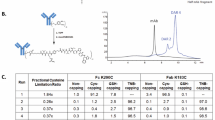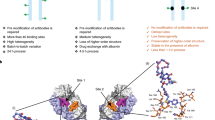Abstract
Many antibody-drug conjugates (ADCs) are unstable in vivo because they are formed from maleimide-containing components conjugated to reactive thiols. These thiosuccinimide linkages undergo two competing reactions in plasma: elimination of the maleimide through a retro-Michael reaction, which results in loss of drug-linker from the ADC, and hydrolysis of the thiosuccinimide ring, which results in a derivative that is resistant to the elimination reaction. In an effort to create linker technologies with improved stability characteristics, we used diaminopropionic acid (DPR) to prepare a drug-linker incorporating a basic amino group adjacent to the maleimide, positioned to provide intramolecular catalysis of thiosuccinimide ring hydrolysis. This basic group induces the thiosuccinimide to undergo rapid hydrolysis at neutral pH and room temperature. Once hydrolyzed, the drug-linker is no longer subject to maleimide elimination reactions, preventing nonspecific deconjugation. In vivo studies demonstrate that the increased stability characteristics can lead to improved ADC antitumor activity and reduced neutropenia.
This is a preview of subscription content, access via your institution
Access options
Subscribe to this journal
Receive 12 print issues and online access
$209.00 per year
only $17.42 per issue
Buy this article
- Purchase on Springer Link
- Instant access to full article PDF
Prices may be subject to local taxes which are calculated during checkout



Similar content being viewed by others
References
Mullard, A. Maturing antibody-drug conjugate pipeline hits 30. Nat. Rev. Drug Discov. 12, 329–332 (2013).
Sievers, E.L. & Senter, P.D. Antibody-drug conjugates in cancer therapy. Annu. Rev. Med. 64, 15–29 (2013).
Okeley, N.M., Alley, S.C. & Senter, P.D. Advancing antibody drug conjugation: from the laboratory to a clinically approved anticancer drug. Hematol. Oncol. Clin. North Am. 28, 13–25 (2014).
Senter, P.D. & Sievers, E.L. The discovery and development of brentuximab vedotin for use in relapsed Hodgkin lymphoma and systemic anaplastic large cell lymphoma. Nat. Biotechnol. 30, 631–637 (2012).
Peddi, P.F. & Hurvitz, S.A. Trastuzumab emtansine: the first targeted chemotherapy for treatment of breast cancer. Future Oncol. 9, 319–326 (2013).
Hermanson, G.T. Bioconjugate Techniques. 2nd Edn. (Academic Press, San Diego, 2008).
Chari, R.V., Miller, M.L. & Widdison, W.C. Antibody-drug conjugates: an emerging concept in cancer therapy. Angew. Chem. Int. Edn Engl. 53, 3796–3827 (2014).
Alley, S.C. et al. Contribution of linker stability to the activities of anticancer immunoconjugates. Bioconjug. Chem. 19, 759–765 (2008).
Shen, B.Q. et al. Conjugation site modulates the in vivo stability and therapeutic activity of antibody-drug conjugates. Nat. Biotechnol. 30, 184–189 (2012).
Baldwin, A.D. & Kiick, K.L. Tunable degradation of maleimide-thiol adducts in reducing environments. Bioconjug. Chem. 22, 1946–1953 (2011).
Ryan, C.P. et al. Tunable reagents for multi-functional bioconjugation: reversible or permanent chemical modification of proteins and peptides by control of maleimide hydrolysis. Chem. Commun. (Camb.) 47, 5452–5454 (2011).
Sassoon, I. & Blanc, V. Antibody-drug conjugate (ADC) clinical pipeline: a review. Methods Mol. Biol. 1045, 1–27 (2013).
Zolot, R.S., Basu, S. & Million, R.P. Antibody-drug conjugates. Nat. Rev. Drug Discov. 12, 259–260 (2013).
Chudasama, V.L. et al. Semi-mechanistic population pharmacokinetic model of multivalent trastuzumab emtansine in patients with metastatic breast cancer. Clin. Pharmacol. Ther. 92, 520–527 (2012).
Strop, P. et al. Location matters: site of conjugation modulates stability and pharmacokinetics of antibody drug conjugates. Chem. Biol. 20, 161–167 (2013).
Toda, N., Asano, S. & Barbas, C.F. 3rd rapid, stable, chemoselective labeling of thiols with Julia-Kocienski-like reagents: a serum-stable alternative to maleimide-based protein conjugation. Angew. Chem. Int. Edn Engl. 52, 12592–12596 (2013).
Jeffrey, S.C. et al. A potent anti-CD70 antibody-drug conjugate combining a dimeric pyrrolobenzodiazepine drug with site-specific conjugation technology. Bioconjug. Chem. 24, 1256–1263 (2013).
Knight, P. Hydrolysis of p-N,N′-phenylenebismaleimide and its adducts with cysteine. Biochem. J. 179, 191–197 (1979).
Kalia, J. & Raines, R.T. Catalysis of imido group hydrolysis in a maleimide conjugate. Bioorg. Med. Chem. Lett. 17, 6286–6289 (2007).
Badescu, G. et al. A new reagent for stable thiol-specific conjugation. Bioconjug. Chem. 25, 460–469 (2014).
Agarwal, P., van der Weijden, J., Sletten, E.M., Rabuka, D. & Bertozzi, C.R.A. Pictet-Spengler ligation for protein chemical modification. Proc. Natl. Acad. Sci. USA 110, 46–51 (2013).
Tian, F. et al. A general approach to site-specific antibody drug conjugates. Proc. Natl. Acad. Sci. USA 111, 1766–1771 (2014).
Doronina, S.O. et al. Development of potent monoclonal antibody auristatin conjugates for cancer therapy. Nat. Biotechnol. 21, 778–784 (2003).
Francisco, J.A. et al. cAC10-vcMMAE, an anti-CD30-monomethyl auristatin E conjugate with potent and selective antitumor activity. Blood 102, 1458–1465 (2003).
Lyon, R.P., Meyer, D.L., Setter, J.R. & Senter, P.D. Conjugation of anticancer drugs through endogenous monoclonal antibody cysteine residues. Methods Enzymol. 502, 123–138 (2012).
Hamblett, K.J. et al. Effects of drug loading on the antitumor activity of a monoclonal antibody drug conjugate. Clin. Cancer Res. 10, 7063–7070 (2004).
Sanderson, R.J. et al. In vivo drug-linker stability of an anti-CD30 dipeptide-linked auristatin immunoconjugate. Clin. Cancer Res. 11, 843–852 (2005).
Wahl, A.F. et al. The anti-CD30 monoclonal antibody SGN-30 promotes growth arrest and DNA fragmentation in vitro and affects antitumor activity in models of Hodgkin's disease. Cancer Res. 62, 3736–3742 (2002).
Dubowchik, G.M. et al. Cathepsin B-labile dipeptide linkers for lysosomal release of doxorubicin from internalizing immunoconjugates: model studies of enzymatic drug release and antigen-specific in vitro anticancer activity. Bioconjug. Chem. 13, 855–869 (2002).
Sun, M.M. et al. Reduction-alkylation strategies for the modification of specific monoclonal antibody disulfides. Bioconjug. Chem. 16, 1282–1290 (2005).
Acknowledgements
We thank our Seattle Genetics colleagues H. Kostner for ELISA analysis of rat pharmacokinetics samples and S. Alley for assistance in pharmacokinetic modeling.
Author information
Authors and Affiliations
Contributions
R.P.L. and P.D.S. conceived the project rationale and wrote the manuscript; R.P.L. performed hydrolysis rate studies with aminoethyl maleimide; J.R.S. performed hydrolysis rate and stability studies with ADCs; T.D.B. and S.O.D. synthesized the drug-linkers; J.H.H. performed radiolabeling and quantitation for pharmacokinetic studies; M.E.A. performed the xenograft studies and rat pharmacokinetic studies; C.L.B. and S.M.D. performed the rat toxicology studies; C.I.L. prepared ADCs for all in vivo studies; F.L. discovered differential antibody pharmacokinetics in SCID and NSG mice.
Corresponding author
Ethics declarations
Competing interests
All authors are employees of Seattle Genetics, Inc.
Supplementary information
Supplementary Text and Figures
Supplementary Figures 1–5 (PDF 469 kb)
Source data
Rights and permissions
About this article
Cite this article
Lyon, R., Setter, J., Bovee, T. et al. Self-hydrolyzing maleimides improve the stability and pharmacological properties of antibody-drug conjugates. Nat Biotechnol 32, 1059–1062 (2014). https://doi.org/10.1038/nbt.2968
Received:
Accepted:
Published:
Issue Date:
DOI: https://doi.org/10.1038/nbt.2968
This article is cited by
-
Modular synthesis of clickable peptides via late-stage maleimidation on C(7)-H tryptophan
Nature Communications (2023)
-
Development of [177Lu]Lu-LNC1003 for radioligand therapy of prostate cancer with a moderate level of PSMA expression
European Journal of Nuclear Medicine and Molecular Imaging (2023)
-
Targeted delivery of cytotoxic proteins to prostate cancer via conjugation to small molecule urea-based PSMA inhibitors
Scientific Reports (2021)
-
The renaissance of chemically generated bispecific antibodies
Nature Reviews Chemistry (2021)
-
Controlled coupling of an ultrapotent auristatin warhead to cetuximab yields a next-generation antibody-drug conjugate for EGFR-targeted therapy of KRAS mutant pancreatic cancer
British Journal of Cancer (2020)



